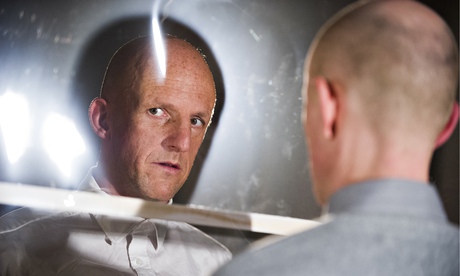
Can theatre offer a cure for psychosis? It's unlikely – and it would be unwise for any theatre-maker even to try. What theatre can do, though, is convey the experience of psychosis: the hallucinations and delusions – often terrifying, sometimes comical – that define reality for those with schizophrenia and related conditions.
This, at least, is the belief shared by David Woods and Jon Haynes, co-founders of the theatre company Ridiculusmus. Their new show, The Eradication of Schizophrenia in Western Lapland, examines the effects of psychosis on several members of a fictional family, using an innovative conceit. The audience is split in two, with each half sitting on either side of a dividing wall. For the first act, each half of the audience watches one scene, while another scene is performed on the other side. Later, the audiences swap places; and in the final section, the wall becomes transparent, so that both halves of the audience are watching the same scene.
The effect, at least at first, is bewildering – and that is the point. "It's as if you're having auditory hallucinations," Woods tells me when we meet during rehearsals at the Basement in Brighton, where the play is beginning a national tour. "Initially it'll be overwhelming, chaotic. Then the audience will go out of the theatre, change sides. Slowly the voices will settle into place. In a way, it's the same with schizophrenia. You don't get cured, but you can recover."
Woods and Haynes know more about schizophrenia and psychosis than most. Haynes was sectioned in the mid-80s, and spent six months as a patient in London's Maudsley Hospital; Woods was a carer for several family members with mental health problems. It was this that first drew them towards making a show about mental illness: a series of early improvisations on the subject of family (the company devise all their work through improvisation and extensive research) threw up memories from their own pasts.
They contacted the Tavistock clinic in London, where they took part in a workshop on child carers for adults with mental health issues. It was there that they first learned about "open dialogue": a revolutionary approach to the treatment of psychosis that has, over the past few decades, virtually eradicated the condition in Western Lapland, the area of Finland where it originated.
Intrigued, Woods and Haynes travelled to the Keropudas hospital in Tornio, Finland, where Dr Jaakko Seikkula first evolved the method - and were so struck by what they found that they decided to make open dialogue the key subject of their show. "I thought: 'Wow, this is wonderful,'" Haynes explains. "I can imagine that if we'd had this kind of approach [in the UK] years ago, things might have been very different for me. When I was ill, I remember feeling very much that I was the problem. With open dialogue, that's not at all how the patient feels."
Open dialogue is, as the name suggests, a treatment based on talking rather than medicating, and on intervening as early as possible in a psychotic episode. Families are directly involved in the patient's therapy, with the aim of identifying the skewed dynamics, or other sources of emotional tension, that may have caused the patient's crisis. "The idea," Seikkula tells me over Skype, "is to organise the psychiatric system in a way that makes it possible to meet immediately in a crisis, and work very intensively together with the family."
The statistics on open dialogue are startling: according to a 2003 study conducted at Keropudas hospital, 82% of patients who were given open-dialogue treatment had no, or mild, psychotic symptoms after five years, compared to 50% in a comparison group. The method has attracted international attention – in 2011, Seikkula helped found the Institute for Dialogic Practice in Massachusetts, to take open dialogue to the US. But it still remains far from the mainstream in many countries, including the UK.
The Eradication of Schizophrenia in Western Lapland has open dialogue as an underlying theme, inherent in the idea of an audience listening to a family's experience of psychosis, much as a psychiatrist might do during an open-dialogue session. Each scene begins with a group of disembodied voices describing the principles of the method, and the psychiatrist character in the play mentions the fact that a colleague in the NHS has been struck off for using open dialogue in the place of anti-psychotic medication.
Haynes and Woods' key aims are to raise awareness of open dialogue, and to dispel the wider stigma surrounding schizophrenia. "I would hope," Woods says, "that people who see the show would start listening: talking to each other rather than just barging their way through life. And that they would realise that there is a lot more to schizophrenia than just the tiny minority who go out and stab somebody with a knife."
Seikkula, too, believes that a piece of theatre such as this has a powerful role to play in expressing what he, and other practitioners of open dialogue, consider the fundamental definition of psychosis. "Psychosis belongs to life," he says. "In my mind, we can all have hallucinations. If we are in a stressful enough situation, each of us can react in that way. This play gives people a very concrete experience of how that really is."
The Eradication of Schizophrenia in Western Lapland is touring the UK. See ridiculusmus.com for full details.
For more information on Open Dialogue, see opendialogueapproach.co.uk

